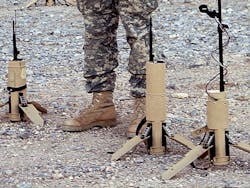Military researchers reach out to industry for open-source software for unattended ground sensors
These devices are designed for deployment for relatively long periods -- from days to as long as months or years -- to detect events like movements of enemy vehicles and soldiers in remote or hidden areas.
Officials of the Virginia Contracting Activity at Patrick Air Force Base, Fla., on Wednesday issued a request for information (VACA-2014-02) for the Open Standard for Unattended Sensor (OSUS) System, full-motion video over Disadvantaged Communication Links program.
The RFI seeks to identify qualified sources and solicit information on how to develop and test open-source software that can deliver full-motion video according to the Open Standard for Unattended Sensor (OSUS).
Unattended sensors typically use a combination of seismic, acoustic, and magnetic sensors, as well as pyroelectric transducers, daylight imagers and passive infrared imagers to detect the presence of persons or vehicles automatically, and report the activity with text or images via terrestrial radio or satellite communications (SATCOM) links to a remote processing, exploitation, and dissemination (PED) station.
Unattended sensors like the U.S. Army Current Force Unattended Ground Sensor (CF UGS) are packaged for concealed emplacement in the field and for long-duration unattended operation. Often these sensors are placed in sleep mode and activate when they detect potential activity to save battery life.
Related: DARPA asks Michigan college to use commercial processes to develop sensors in record time
Other kinds of unattended sensors could be placed on ocean buoys, tethered aerostats, on towers, or along fence lines in perimeter security systems.
The OSUS, formerly known as Terra Harvest, aims to promote interoperability among unattended sensor systems for military intelligence, surveillance, and reconnaissance (ISR), civilian law enforcement.
From industry, government researchers want information on innovative solutions that can be included in the OSUS architecture. More information on the OSUS is online in .pdf form at https://www.fbo.gov/utils/view?id=d83fbae989ca0767d3ee583cd2dee436.
Related: Manpackable, throwable robots hit their stride on the battlefield
The program seeks to develop a scalable, open-source full-motion video extension for the OSUS system standard. The extension will build on existing application programming interfaces (APIs) in the OSUS standard. This new capability should enable an OSUS-compliant system to process and transmit full-motion video.
From industry, researchers are asking for information on innovations and the current state of the art in full-motion video and streaming data through an OSUS controller that involves:
-- unconstrained communications and high bandwidth; pass-through for real-time display.;
-- constrained communications and low bandwidth; graceful degradation; low power constraints;
-- onboard store and forward: encryption for data at rest, storage, and format; and
-- onboard processing and algorithms: compression, event and context processing & exploitation.
Related: DARPA chooses Sparton to help develop hidden weapons and sensors that pop up from the ocean
Companies responding must have proven experience in open-source software for unattended sensor systems; open-source compression algorithms; and open-source error correction algorithms.
Companies interested should email responses no longer than 20 pages to the Virginia Contracting Activity's William Patterson at [email protected] no later than 14 March 2014.
For questions or concerns contact the Virginia Contracting Activity's William Patterson by phone at 321-494-2998, or by email at [email protected].
More information is online at https://www.fbo.gov/spg/ODA/DIA/DIAFL/VACA-2014-02/listing.html.
